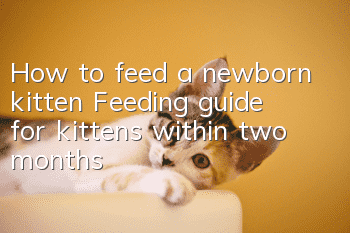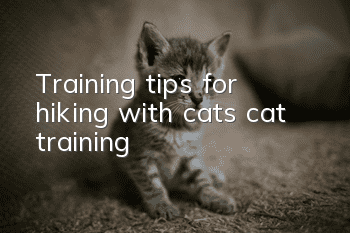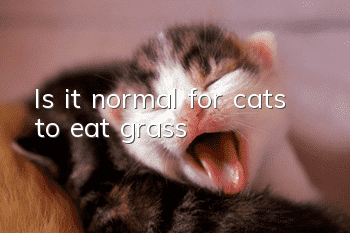How to feed a newborn kitten? Feeding guide for kittens within two months

The owner of the family gave birth to a kitten. This is the first time for a kitten to be raised and she doesn’t know how to raise a kitten. In fact, the kitten needs to be fed goat milk powder and cannot eat other food; and it needs to be stimulated with gauze dipped in water. During defecation, measures should be taken to prevent cold and warmth, and avoid being exposed to wind. By the fourth week, you can start feeding softly soaked cat food.
How to feed a kitten in the first week
1. A newborn kitten is generally about 11-15cm in length and weighs about 70g-135g. The eyes cannot be opened yet and are very delicate and require special care. Their gastrointestinal system is only suitable for digesting and absorbing milk. If you need to artificially feed milk powder, you need to choose milk powder specifically for cats. Because kittens lack the enzyme to digest lactose, they will develop lactose intolerance.
2. Kittens cannot produce less colostrum in the first 3 days because they cannot produce antibodies in their bodies, and the mother cat’s antibodies can be secreted through the colostrum. The kitten’s intestines can easily absorb the antibodies in the colostrum, thus making the kitten Gain passive immunity, which is important to protect your kitten's health.
3. If artificial feeding is required, feeding must be started within 24 hours and maintained every 2 hours. Use a pet-specific feeding bottle. The prepared milk should not be too cold or too hot. It is better to pour it on the back of your hand without burning it. After feeding, imitate the mother cat's licking action with your hands or a dry towel, massage the kitten's body, or gently pat the kitten's side until it burps.
4. After each drink of milk, help the kitten to urinate at an interval of about two hours. You need to manually stimulate the kitten to urinate and defecate. Use a cotton swab to gently tap the kitten’s external genitals to stimulate urination and defecation.
5. The kitten cannot regulate its own body temperature at this time. On the one hand, it relies on its mother to keep warm. On the other hand, you can prepare an electric blanket or hot water bottle. Be careful not to burn the kitten. Cat litters and mother cat feeding utensils need to be disinfected every day. Keep the cat's nest clean, ventilated, and protected from light to create a healthy and quiet environment for them.
How to feed a kitten in the second week
1. When the kitten’s eyes slowly open about 10 days after birth, you can gently wipe the eyes with a cotton swab dipped in water. If a kitten does not open its eyes all the time, it may be blind and requires more observation. The initial eye color is usually gray-blue, which is not the cat's original eye color, and the kitten's ears gradually stand up. At this time, the kitten can distinguish four tastes: sour, sweet, bitter, and salty, but its sensitivity to sweetness is relatively weak.
2. If it is artificial feeding, you should still feed every 2 hours during the day and every 4 hours at night.
3. Starting from the 2nd week, you can choose a time when the sun is not so strong (morning or afternoon), move the cat’s nest to a sunny place, and let them bask in the sun., which is beneficial to the cat’s physical development.
How to feed kittens in their third week
Kittens begin to learn to crawl when they are 16 to 20 days old. If there are too many kittens in a litter, the mother may not be able to take care of them, and the owner needs to observe more and send the kittens that crawl away to the mother. At the same time, the growth of each kitten should be carefully observed to ensure that the mother cat's milk can satisfy each kitten. If it is artificial feeding, it needs to be fed every 3 to 4 hours.
How to feed kittens in the fourth week
1. The kitten slowly grows primary canine teeth (two canines on each upper and lower jaw) and small incisors on the upper jaw. Weaning can begin at this time, because the kitten's teeth will hurt the mother cat's nipples. Soak the kitten's cat food in warm water until soft, and then mix it with some milk powder (milk powder for pets).
2. Kittens need 4 times the energy at this time than adult cats, so be sure to choose high-quality kitten food. Watch your kitten's poop. At this time, the kitten's intestines and stomach are very fragile. Improper feeding or improper food selection can easily cause the kitten to die. The process of switching from breast milk to food is a very important transition period for kittens.
How to feed kittens in their fifth week
Kittens can slowly learn to walk around the 5th week. This is the fastest period for their body growth. They can completely convert breast milk into food when eating. Be sure to soak the food until soft before feeding. Generally, use 40 degrees Celsius. Soak in warm water for more than half an hour. On the basis of normal feeding, some nutrients can be added to meet the nutritional needs of kittens during this special period.
How to feed a kitten in the sixth week
The kitten’s deciduous teeth have all grown in, so it can try to run slowly. At this time, kittens have weak resistance and are susceptible to various parasites. They need to be dewormed and vaccinated according to the immunization program. Eat small and frequent meals every day, usually 4 to 5 times is better. Prepare fresh drinking water for kittens (preferably flowing water). At this time, you can buy some toys for the kittens to interact with to ensure that they get some appropriate exercise every day to help them grow healthier.
How to feed a kitten in the seventh week
At this time, the kitten can learn to use the litter box to go to the toilet under the guidance of the mother cat. They began to imitate the movements of their mother cats and follow them in various activities. If the mother cat is not around, the owner must teach the kitten to use the litter box step by step.
At this time, the healthy kitten can be given the first water test (bath). One week after vaccination, the kitten can be given a bath.It is also a behavioral training so that they will not be afraid of bathing when they grow up. At the same time, cat paw boards should be prepared for kittens so that their claws can be targeted and will not cause unnecessary trouble to the home environment.
As kittens grow up, owners should try to communicate with them as much as possible and conduct more interactive activities. This kind of emotional and physical close contact during the kitten period will lay a good foundation for their character. The cultivation of the kitten's behavior and character is as important as their healthy feeding. Please do not ignore it.
- What are the benefits to cats of eating acidified food?
- Can cats drink light salt water if they have heatstroke?
- Why did a Ragdoll cat have diarrhea after eating canned food? What caused it?
- Why cats like to drink milk
- Will British shorthair cats become dependent on probiotics if they often eat them? A must-read for pet owners!
- How to treat nasal branch in Balinese cats
- What should a novice prepare for raising a cat for the first time?
- Misunderstandings about deworming | How to correctly deworm parasites on cats?
- What to do if there is poop on the cat’s anus
- Why do Cornish Rex cats need to be neutered?



